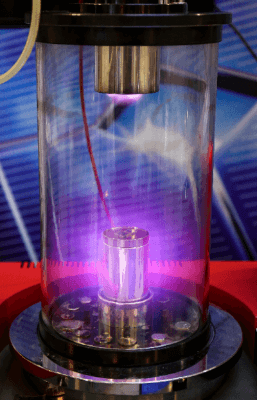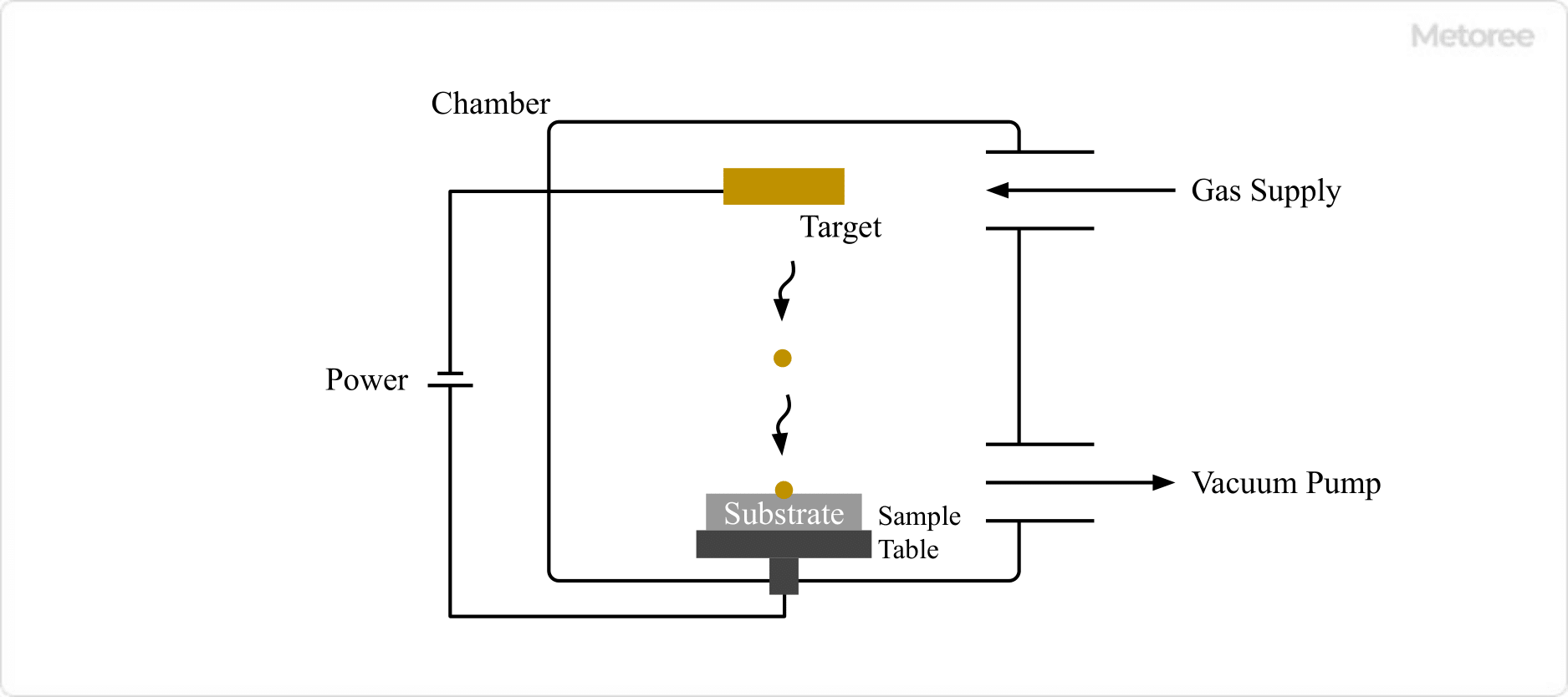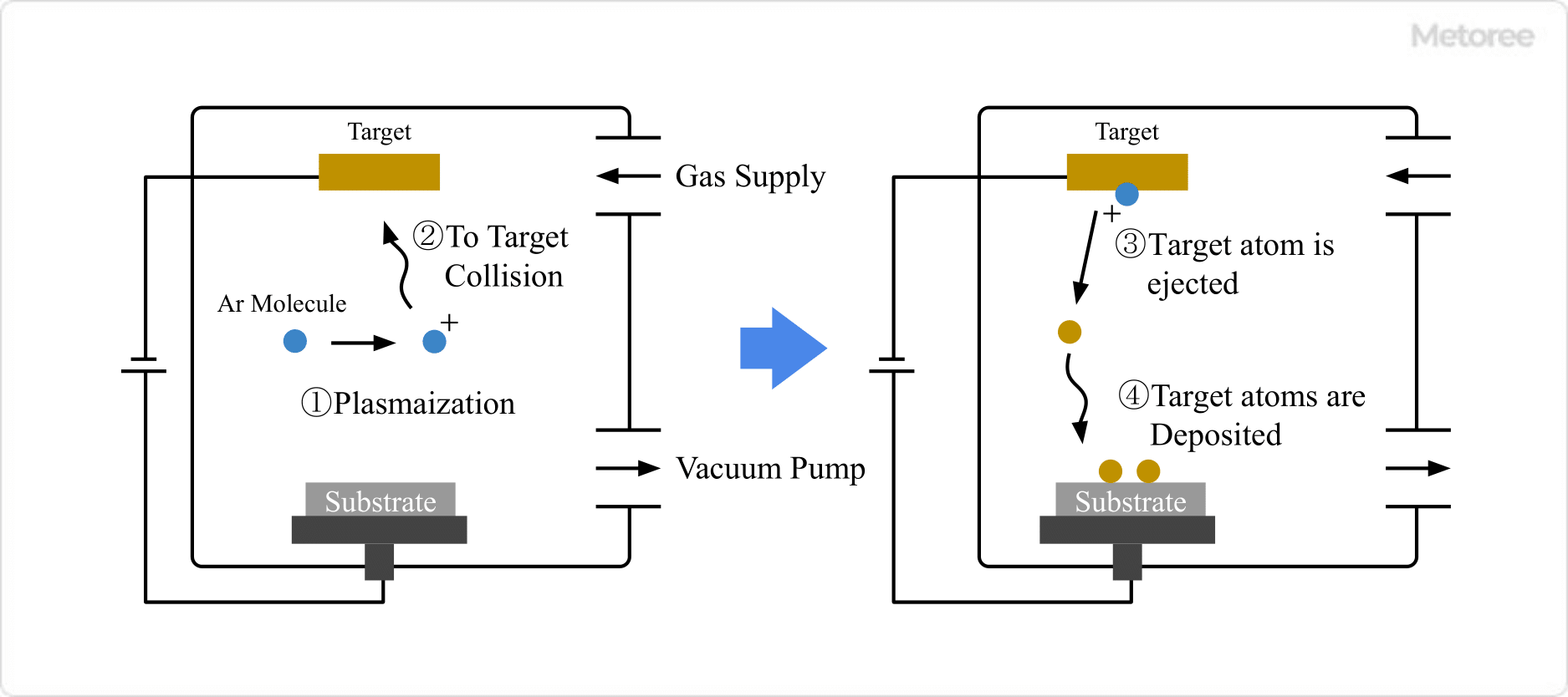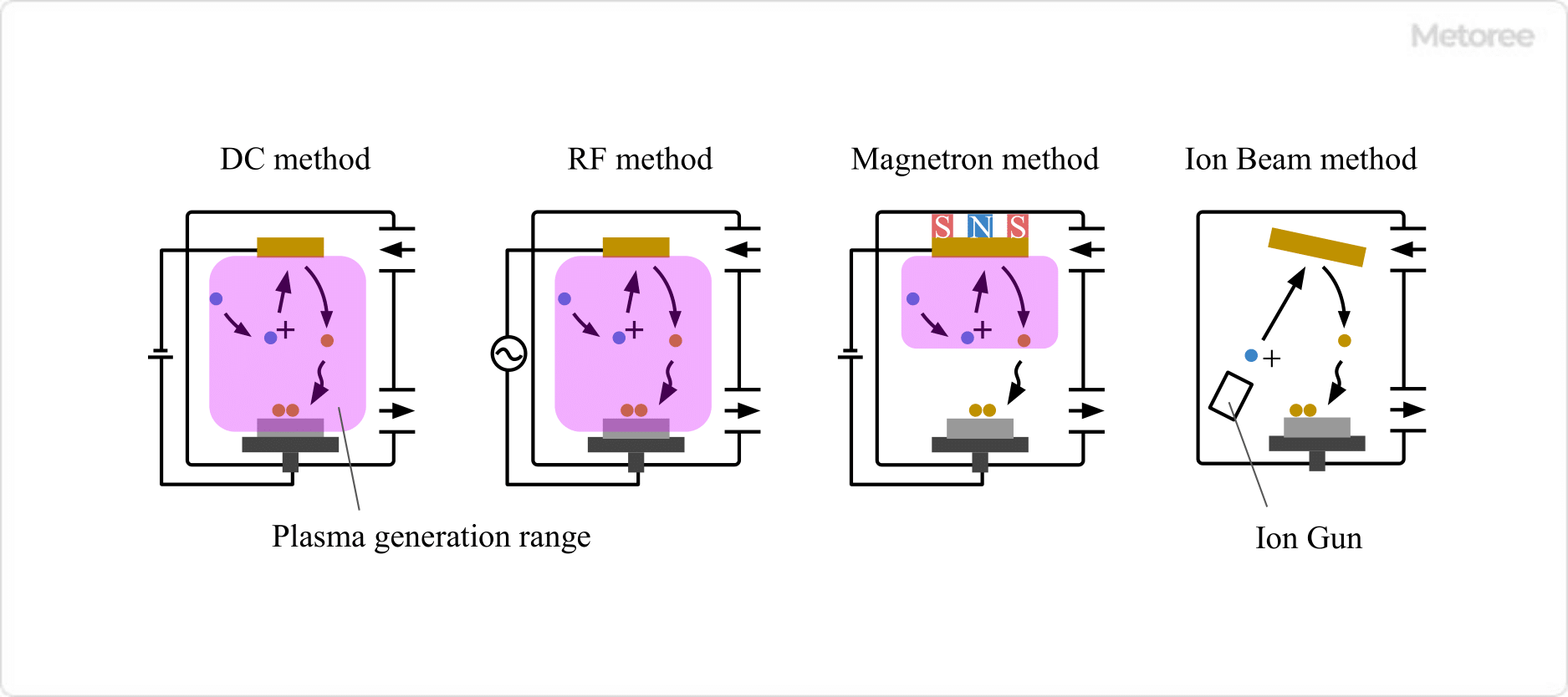







9 Sputtering Equipment Manufacturers in 2024
This section provides an overview for sputtering equipment as well as their applications and principles. Also, please take a look at the list of 9 sputtering equipment manufacturers and their company rankings. Here are the top-ranked sputtering equipment companies as of July, 2024: 1.Alliance Concept, 2.Vapor Technologies, Inc., 3.Blue Wave Semiconductors.
Table of Contents
What Is Sputtering Equipment?

Sputtering equipment is a device that performs sputtering to create a very thin film uniformly on the surface of an object.
Sputtering is a physical vapor deposition (PVD) method, like vacuum evaporation and ion plating. Sputtering is used in various fields, including the deposition of semiconductor and liquid crystal films. It is also used to clean the surface of objects.
Uses of Sputtering Equipment
Sputtering equipment is used to fabricate thin films for semiconductors, liquid crystals, and plasma displays. Compared to other PVD evaporation systems, sputtering equipment is capable of depositing metals and alloys with high melting points, and thus has a wide range of applications.
Recently, metals have been deposited on the surface of plastic, glass, and film to make them conductive and used as transparent electrodes and wiring for touch panels. This, further expands the range of applications for sputtering equipment.
In addition, medical devices and miscellaneous goods with antibacterial properties coated with photocatalytic titanium dioxide on their surfaces are also available. It is also used in analytical applications, such as sample preparation for scanning electron microscopes (SEM).
Structure of Sputtering Equipment

Sputtering equipment mainly consists of the following components:
- Vacuum chamber
- Sample stand
- Sputtering target
- Exhaust system (rotary pump, etc.)
- Gas supply system
- Power supply (high frequency, High-voltage power supply, etc.)
The vacuum chamber contains a sample stand that holds the substrate and a sputtering target that supplies the sputtering material, while the vacuum pump and gas supply system are connected to the chamber.
Principle of Sputtering Equipment

The principle of sputtering equipment is to deposit a film on the surface of an object by applying high voltage under vacuum and repelling the atoms of the film material. First, the chamber is sufficiently depressurized by a pump, and then inert gases such as argon are filled into the equipment at a constant pressure.
When a high negative voltage is applied to the target, which is the material for the thin film, and a glow discharge is generated, the argon filled in the equipment becomes plasma and collides with the target on the cathode, causing the Ions, atoms and molecules on the target to be ejected. The target atoms are then deposited on the surface of the target to which the positive voltage is applied, resulting in the production of a thin film.
Types of Sputtering Equipment
There are various types of sputtering methods.

1. DC Method
This method applies DC voltage between electrodes. This method has various advantages, such as a simple structure. However, the disadvantages include the possibility that the sample may be damaged by the high-temperature plasma and the inability to form a film properly if the sputtering target is an insulator.
2. RF Method
This method applies a high-frequency AC voltage between electrodes to form films on materials such as ceramics, silica and other oxides, metal oxides, and nitrides, which cannot be formed by the DC method.
3. Magnetron Method
This method uses a magnet to create a magnetic field on the target side to keep the plasma near the target. This not only reduces damage to the sample caused by the plasma, but also increases the plasma generation speed, resulting in faster film formation. Various power supply methods are available, including DC, AC, and high-frequency AC. On the other hand, the target is reduced unevenly and the utilization efficiency tends to be low.
4. Ion beam Method
Ions are produced at a separate location from the target or sample and accelerated to the target. Since there is no discharge in the chamber, the effect on the sample is minimized and there is no need to consider the adhesion of impurities or the conductivity of the target.
In addition to the above, there are various types of sputtering equipment, such as Electron Cyclotron (ECR), which should be selected appropriately according to the application and budget.
Other Information on Sputtering Equipment
Features of Sputtering Equipment
Sputtering equipment can make the film thickness uniform, and since it uses electrical properties, it can increase the strength of the film. It can produce films of high-melting-point metals and alloy materials, which is difficult with other PVD methods. Another method is to fill oxygen instead of argon or other inert gases to deposit oxide films.
However, there are some disadvantages, such as the longer time required for film deposition compared to other PVD methods and the risk of damaging the sputtering target by the generated plasma.
List of 9 Sputtering Equipment Manufacturers
*Including some distributors, etc.
Sort by Features
- Default
- Company Size: largest first
- Year Founded: oldest first
- Year Founded: earliest first
Sort by Area
- United States of America
- France
- India
- Japan
-
-

-
Vapor Technologies, Inc.
Sputtering System
Manufacturer Overview
VaporTech designs, builds, and services thin-film coating equipment which deposit PVD and PE-CVD coatings to enhance the quality of numerous products. We exhibit a steadfast commitment to our craft, recognizing that a product's finish is a direct reflection of its quality, underlining a brand's dedication to quality and value. For over three decades, VaporTech's PVD coating equipment has been assisting customers in applying stunning and durable hard coatings that not only enhance but differentiate the aesthetics, texture, and functionality of a plethora of items including home hardware, medical devices, automobiles, industrial tooling, consumer electronics, sporting goods, among others. We are located in Longmont, Colorado, extending our sales, service, and support on a global scale.
-
-
-
-

-
Semicore Equipment, Inc.
Sputtering System
Manufacturer Overview
Semicore Equipment, Inc. is a deposition equipment and custom vacuum systems manufacturer based in Livermore, California since 1996. The company showcases a diverse product catalog, serving multiple fields like the electronics, optical, solar energy, medical, and automotive industries. It produces items such as sputtering, evaporation, PVD coating and custom systems, as well as DLC tribology coaters and magnetron sputtering cathodes. In addition, the venture offers tooling and fixturing, innovative solutions and automation control services.
-
-
-
-

-
Blue Wave Semiconductors
Sputtering System
Company Overview
Blue Wave Semiconductors was established in the year 2000, located in Baltimore, USA and it is a manufacturer and supplier of thin-film deposition systems. The company manufactures products such as deposition equipment, CVD diamond machine systems, and electron beam evaporators. The company also provides services like thin-film coatings, CVD diamond coatings, metal deposition and optical coatings. It's R&D services include CVD diamond coatings on custom structures and parts. The company is ISO certified.
-
-
-
-

-
ULVAC, Inc
Sputtering System
Manufacturer Overview
Ulvac Inc., established in 1952 and headquartered in Kanagawa, Japan, is a manufacturer of vacuum equipment, components, peripheral devices, and materials for the solar cell and semiconductor industries, among others. The company operates businesses in six areas, including materials, components, electronic devices, semiconductors, and flat panel display production equipment. Some of its products include roll coaters, semiconductor production equipment, LED production equipment, leak detectors, and vacuum brazing furnaces. It is ISO9001 certified, and its net sales in the 2022 fiscal year were 227.5 billion Japanese Yen, with 34% of this amount coming from semiconductor and electronic device production equipment.
-
-
-
-

-
Alliance Concept
Sputtering Machine
Manufacturer Overview
Alliance Concept, based in France, is a manufacturer of vacuum systems and equipment since 1991. The company excels across three distinct sectors: thin film deposition, leak testing, and vacuum technology. The company designs and produces cutting-edge frames or thin film deposition. This technology finds extensive use in various industries, enabling precise and controlled deposition of thin films onto surfaces. The company's proficiency extends to leak testing, a critical process for ensuring the integrity of products that require containment. Furthermore, its expertise in vacuum technology covers a broad spectrum of applications.
-
-
-
-

-
CANON ANELVA CORPORATION
Sputtering Equipment
Manufacturer Overview
CANON ANELVA is a manufacturer and supplier of vacuum deposition systems and related systems headquartered in Kanagawa, Japan. The company was established in 1967 and specializes in producing a wide array of products that cater to sectors such as semiconductor manufacturing, electronics, and beyond. The company's product portfolio includes vacuum deposition systems, spluttering equipment, and other advanced technology solutions designed to meet the demands of modern manufacturing processes. These products play an integral role in enhancing the efficiency and performance of manufacturing processes across a diverse range of applications.
-
-
-
-

-
Sputtering Components
e-Cathode Process Lids and Doors
Manufacturer Overview
Sputtering Components, a member of the Bühler Group, established in 2001 and headquartered in Owatonna, USA, is a manufacturer of vacuum coating systems and related components. The company offers end blocks, magnetrons, and complete lid systems, enabling the production of windows, smartphones, and automotive components. Using Solidworks for 3D modeling, it employs finite element analysis for magnetic and thermal simulations. The company fabricates components with diameters ranging from 0.1 to 60 inches. Its rotary magnetron technology serves solar cells, touch screen production, and decorative coatings, while its swing-duotm software enhances coating uniformity through optimized magnet bar movement.
-
-
-
-
-
Omicron Scientific Equipment Co.
DC Magnetron Sputtering System
Company Overview
Omicron Scientific Equipment was established in the year 2000 based in New Delhi, India and it is a manufacturer, supplier, and exporter of scientific equipment. The company manufactures products like microwaves, radio frequency equipment, DC power supplies, thermal evaporation systems, electron beam gun-based evaporation systems, spin coating systems, scrubbers, semiconductor processing equipment, chemical benches, equipments for research and development and vacuum furnaces. The company is a member of Trade India and is also ISO certified.
-
-
-
-
Sputtering Equipment Manufacturer Ranking
*Including some distributors, etc.Ranking as of July 2024
Derivation Method| Rank | Company | Click Share |
|---|---|---|
| 1 | Alliance Concept |
17.0%
|
| 2 | Vapor Technologies, Inc. |
14.3%
|
| 3 | Blue Wave Semiconductors |
14.0%
|
| 4 | ULVAC, Inc |
12.8%
|
| 5 | Omicron Scientific Equipment Co. |
10.6%
|
| 6 | Semicore Equipment, Inc. |
10.6%
|
| 7 | CANON ANELVA CORPORATION |
8.3%
|
| 8 | Sputtering Components |
6.4%
|
| 9 | Japan Create Co., Ltd. |
6.0%
|
Derivation Method
The ranking is calculated based on the click share within the sputtering equipment page as of July 2024. Click share is defined as the total number of clicks for all companies during the period divided by the number of clicks for each company.Number of Employees
- ULVAC, Inc: 6,235
- CANON ANELVA CORPORATION: 1,072
- Alliance Concept: 48
Newly Established Company
- Omicron Scientific Equipment Co.: 2000 (24 years ago)
- Alliance Concept: 1991 (33 years ago)
- CANON ANELVA CORPORATION: 1967 (57 years ago)
Company with a History
- ULVAC, Inc: 1952 (72 years ago)
- Japan Create Co., Ltd.: 1963 (61 years ago)
- CANON ANELVA CORPORATION: 1967 (57 years ago)
Sputtering Equipment Manufacturers in United States
*Including some distributors, etc.
Global Distribution of Sputtering Equipment Manufacturers by Country
*Including some distributors, etc.
| Country | Number of Companies | Share (%) |
|---|---|---|
 United States of America
United States of America
|
3 | 37.5% |
 Japan
Japan
|
3 | 37.5% |
 France
France
|
1 | 12.5% |
 India
India
|
1 | 12.5% |
List of Sputtering Equipment Products
31 products are listed.
Vacuum device
Sputter device 4 inch turtle get precious metal coat with full automatic function MSP-20-MT
20+ people viewing
Magnetron Patta device is applied to promote ionization on the cathode surface layer using a powerful magnet on the back of the target, and apply a...
SHINKO SEIKI CO., LTD.
Sputtering device for thin film formation equipment research and development
30+ people viewing
It is a compact hard configuration that is ideal for experiments and basic research. We provide low -cost and reliable hardware. Road lock type eq...
Vacuum device
Spatta device Small magnetron patta device MSP -mini
20+ people viewing
Magnetron Patta device is applied to promote ionization on the cathode surface layer using a powerful magnet on the back of the target, and apply a...
Vacuum device
Spatta device 8 inch target precious metal coat MSP-8in
20+ people viewing
Magnetron Patta device is applied to promote ionization on the cathode surface layer using a powerful magnet on the back of the target, and apply a...
Vacuum device
Sputter device for FE-SEM tungsten coat MSP-20-TK
20+ people viewing
Magnetron Patta device is applied to promote ionization on the cathode surface layer using a powerful magnet on the back of the target, and apply a...
SHINKO SEIKI CO., LTD.
Thin film forming device batch sputtering device
30+ people viewing
This is a lineup of batch -type sputtering devices that are ideal for mass production from various electronic devices and high -performance materia...
SHINKO SEIKI CO., LTD.
Rigid membrane formation device Arc discharge type magnetron Pattadling device
20+ people viewing
It is an fully automatic sputtering device equipped with a high -density magnetron cats (arc discharge -type magnetron codel) developed independent...
SHINKO SEIKI CO., LTD.
Thin film forming device multi -buspattting device
30+ people viewing
This is the latest sputter ring device that can be flexible regardless of the substrate or application, such as SI wafer, glass and ceramics. The ...
Japan Create Co., Ltd.
Multi -unit sputtering device equipped with a unique spatta cats
10+ people viewing
■ Characteristics ・ Equipped with our own spatta cathode ・ Equipped with a 3 -axis mechanism (up and down, rotation, rotation) on the board stage...
SHINKO SEIKI CO., LTD.
Thin film forming device inline spatta ring device
20+ people viewing
It is a passion -type inline type sputtering device for glass substrates. The rectangular cathode is equipped with a multi -unit, so you can arbit...
SHINKO SEIKI CO., LTD.
Thin film forming device Road Rocks Patta ring device
90+ people viewing
It is a road rock -type sputtering device that realizes space. The maximum φ270 tray can be set as standard in the cassette room, and continuous sp...
Vacuum device
Spatta device Multipurpose Simple operating type Magnetron Patta Silamon Memoral Ms. MSP-40T
20+ people viewing
Magnetron Patta device is applied to promote ionization on the cathode surface layer using a powerful magnet on the back of the target, and apply a...
Panasonic Production Engineering Co., Ltd.
Multi -chamber -type sputtering device S800
10+ people viewing
■ Features ・ Multi -chamber type and support a wide variety of processes ・ The unit of our S600 device can be installed ・ Maintenance of long -t...
Japan Create Co., Ltd.
Sputtering technology Applied screw stirring powder sputtering device
10+ people viewing
■ Overview This is a device that uses sputtering technology that we are good at, and forms a variety of three -dimensional metals, ceramic, and res...
SHINKO SEIKI CO., LTD.
Thin film formation device wrapping type sputtering device
70+ people viewing
Last viewed: 17 hours ago
This is the latest RTOR type film model device that realizes not only resin but also metal foil continuous winding processing. Each mechanism, such...
SHINKO SEIKI CO., LTD.
Thin film forming device super high vacuum sputter ring device
20+ people viewing
It is an ultra -high vacuum compatible sputtering device with a 10 -PA background exhaust performance in the spatta room. It consists of 6 rooms i...
Vacuum device
Completely automatic magnetron patta device for spatta equipment electron microscope MSP-1S
20+ people viewing
Magnetron Patta device is applied to promote ionization on the cathode surface layer using a powerful magnet on the back of the target, and apply a...
Vacuum device
Sputter device with full automatic function precious metal coat MSP-20-Um
20+ people viewing
Magnetron Patta device is applied to promote ionization on the cathode surface layer using a powerful magnet on the back of the target, and apply a...
Panasonic Production Engineering Co., Ltd.
Multi -layer film sputtering device S600
20+ people viewing
■ Features ・ Both a variety of processes and high productivity with up to 5 cathodes ・ Maintenance of long -term hyperchd and uniformity by adjus...
Japan Create Co., Ltd.
Equipped with unique spatta cats
10+ people viewing
■ Characteristics ・ Equipped with our own spatta cathode ・ Equipped with a 4 -axis mechanism (up and down, turned, rotation, tilt) in the work st...



















